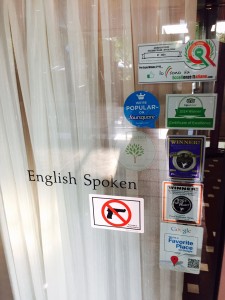
This still from the Safe Havens International Safe Topics The First 30 Seconds evaluation and staff development set depicts a woman with a knife in the front office of a school. School crisis scenario testing is one of the most powerful assessment tools for measuring how well prepared school personnel are to make effective and fast life-saving decisions. Safe Havens has now released five free audio scenarios which can help organizations evaluate and improve emergency preparedness.
Safe Havens International began using verbal scenarios in our school security assessment processes many years ago. About 12 years ago, we began creating video crisis scenarios for use in training for clients and for our conference keynote sessions. While trying to help a large urban school district figure out why an experienced administrator failed to take life-saving action which resulted in a student’s death, we found that it was quite revealing to have school administrators respond to our scenario videos in a real-time fashion. During this assessment, I ran scenarios with five very experienced building administrators. When presented with a scenario of an angry parent depicted as threatening front office staff with a large knife, three of the five administrators stated they would ask the woman to come into their office and that they would persuade her to surrender the weapon. None of the five administrators opted to request police assistance or to issue a lockdown for the school. As some of the administrators had armed and sworn police officers assigned to their buildings, this was quite a shock. As this assessment involved a large urban school district with more than 100 schools we were even more surprised.
School Crisis Scenarios Reveal Astounding Gaps
Since that time, our analysts have conducted more than 5,000 one-on-one crisis simulations where representative school employees were asked to respond to a variety of school crisis scenarios in a real-time fashion. Our award winning video team has now produced approximately 100 scripted, audio and video scenarios depicting a wide array of crisis situations. We have developed scoring tools and have embedded the scenarios and the scoring tools into our web-based school security assessment evaluation tool. The results of these simulations have been nothing short of amazing.
School Crisis Scenario Sets
Several years ago, Safe Havens invested more than $250,000 to produce two sets of crisis simulations which are available on our website. One set includes school-based scenarios and the other set is focused on school bus scenarios. These evaluation and staff development sets have been very popular. Last week, our video unit completed five new audio scenarios that have been designed as a free resource. While this resource does not include the companion training videos, video scenarios, scoring tools, and other resources included in the sets in our web store, they are valuable free tools. The scenarios are available as a free MP3 download so they can be played on smart phones, tablets and laptops to initiate drills, conduct limited evaluations and for use in staff development sessions.
Free Audio Crisis Scenarios for any setting
These free crisis scenarios are intentionally recorded to be used in any setting. Developed in cooperation for Campus Safety Magazine as a free resource for attendees at the 2015 Campus Safety Conference in Chicago, they have already generated considerable interest. Be sure to check out these scenarios at: http://safehavensinternational.org/staying-alive/

